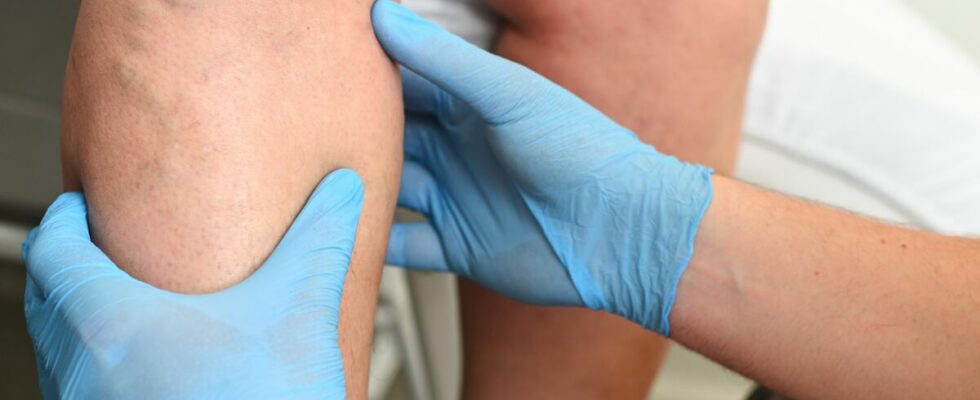Pain, redness and swelling in the calf? Symptoms not to be neglected! According to Inserm, between 50 and 100,000 phlebitis occur each year in France. Venous thrombosis can lead to sometimes serious complications, in particular pulmonary embolism responsible for 10 to 20,000 deaths per year.
Phlebitis: what are we talking about?
Phlebitis or venous thrombosis is characterized by the formation of a blood clot (thrombus) in a vein. “And this, whatever the location of the vein: a leg, an arm, the stomach or even the brainimmediately specifies Dr Sébastien Gracia, vascular doctor. Even if phlebitis is most often located in the lower limbs.
There are two types of phlebitis:
- superficial phlebitis or paraphlebitis when a blood clot forms in a superficial vein: for example the saphenous veins in the lower limbs or the basilic vein in the forearm.
- deep phlebitis which forms, as its name suggests, in a deep vein and must be treated quickly in order to avoid the risk of pulmonary embolism.
“It was long thought that only deep phlebitis was seriouscontinues Dr. Gracia. However, paraphlebitis can also present potential complications which mean that today it is treated with injections in certain conditions.”
What are the symptoms ?
Venous thrombosis generally presents with a triad of symptoms: redness, swelling and pain in the leg or calf. “These are the classic clinical signs, confirms Dr. Gracia. We should consider phlebitis in the event of a swollen, painful and red calf without a history of blows and in the presence of risk factors such as pregnancy, orthopedic surgery, etc.”
What are the risk factors?
Several factors increase the risk of venous thrombosis:
- immobilization : for example, when you are bedridden for health reasons or when you wear a cast. “The venous return is then less important”explains the specialist.
- there orthopedic surgery particularly of the knee or hip;
- cancers : “30% of people who have cancer will have phlebitis or pulmonary embolism and this is generally a poor prognostic factor for cancer”specifies Dr. Gracia.
- venous insufficiency which manifests itself by a feeling of heavy legs and the presence of telangiectasias (small blue or purplish veins under the skin) or varicose veins;
- pregnancy, childbirth and oral contraceptives containing estrogens;
- age : the older you get, the more the risk of phlebitis increases.
- hypercoagulability of blood linked to a genetic predisposition: for example, a congenital deficiency in certain coagulation factors such as protein S or protein C. “It should be noted that hypercoagulability can also be increased in the event of inflammatory pathologies such as rheumatoid arthritis”adds the vascular doctor.
How to diagnose phlebitis?
Faced with clinical signs suggestive of venous thrombosis, the doctor will prescribe a Doppler ultrasound. This completely painless imaging technique allows you to examine deep and superficial veins, visualize blood flow and ensure that there is no possible clot.
Phlebitis: how to treat it?
The treatment of venous thrombosis is based on the administration of oral or injectable anticoagulants. “Today, in almost all cases, oral treatment will be prescribedspecifies Dr Sébastien Gracia. The appearance of a new generation of medications – direct oral anticoagulants – has changed our practice and made it possible to limit the use of injections.”
The treatment will be continued for a period of 3 to 6 months. “After three months, we reassess the risk of recurrence and the duration of treatmentexplains the specialist. For example, a patient who has phlebitis following the installation of a hip prosthesis, when he walks normally again, we know that we will be able to eliminate this risk factor and therefore stop the anticoagulants. On the other hand, when phlebitis occurs without a contributing factor, it can potentially recur. In this case, depending on its severity and whether or not it is associated with a pulmonary embolism, it is sometimes indicated to continue treatment throughout life with the risk of bleeding that goes with it.”
What are the complications of phlebitis?
Phlebitis can cause pulmonary embolism, a very serious complication characterized by migration of a blood clot into a pulmonary artery and manifests itself as chest pain and dyspnea (shortness of breath). “It can also lead to long-term complications such as venous ulcers due to subsequent obstructive clots in the veins”adds the specialist.
How to prevent the risk of recurrence of phlebitis?
Wearing compression (compression socks) improves venous return, limits the risk of recurrence of phlebitis and promotes the complete destruction of a clot. “We also recommend that patients be active, limit risk factors and be attentive to the signs of phlebitis: in the event of a red and painful calf, they must consult without delay“, concludes Dr Sébastien Gracia.
